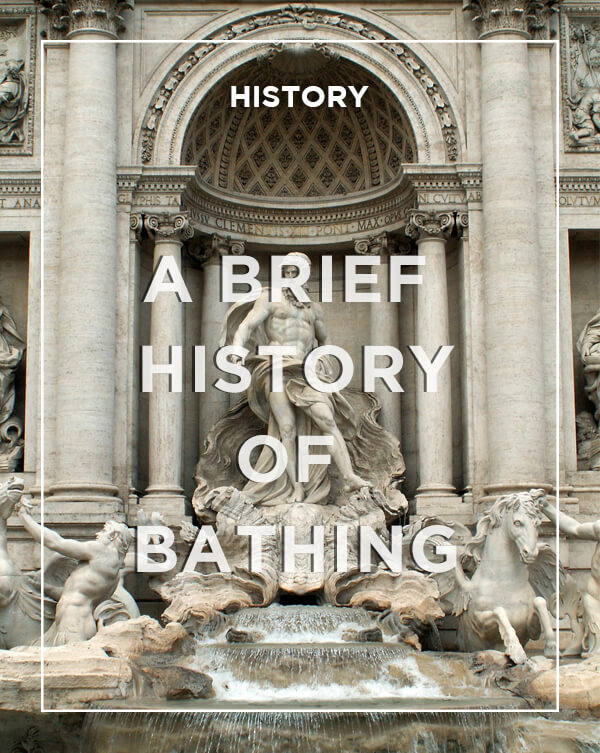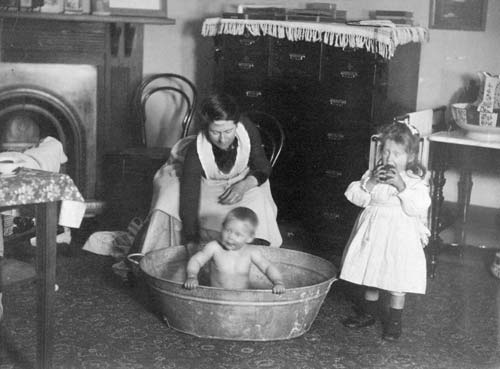Tags
A reader of my fantasy sci-fi series, Pearseus, once joked that I have a strange fascination with showers. And it’s true; I think of them as a great example of things we take for granted but are actually pretty new.
In this day and age, we enjoy a lot of conveniences that were anything but as recently as 100 years ago. One of those things includes taking a bath. Thanks to history books and television shows depicting times hundreds of years ago, we are led to believe that humans were barbaric, dirty beings that would go without bathing for days, weeks, and months at a time.
Which is far from true. Different cultures had their own different bathing rituals, developed for religious, hygienic, social, and therapeutic reasons.
Ancient Times
We are a bit spoiled in the modern age. We have access to the internet, which allows us to check various sites for as diverse issues as taking care of our dogs, knowing how to choose a pool heater, building our own hot tubs, and checking sites like Valuehunta for everything else.
But back in ancient times, we didn’t have access to these things. Moreover, bathing was something that could only be done communally in bodies of water like rivers and seas if one could not afford private bathing.
People were bathing mostly for hygienic methods, not for the various benefits that a good soak can offer. Some of the earliest civilizations had public bath systems so that everyone could enjoy the benefits of a good bath even if they didn’t have access to a private bath facility.
The Ancient Egyptians
Around 1,500 BC, the Egyptians placed a high level of importance on the rituals behind bathing, washing, and even cosmetics. This is because they believed that being cleaner put them closer to god (cleanliness is next to godliness, after all).
Egyptians also began to use clay for soap and a scented paste for scrubbing themselves. Essentially, this was the earliest form of washing. They scrubbed their hands, feet, and faces using these materials as well as shaving their hair.
Ancient Rome
By the time the Roman era began, the concept wasn’t exactly new anymore. But the city of Bath became a staple for bathing culture in Rome during its penultimate period. It should come as no surprise that Bath became the city of bathing with a wide swath of public baths that featured sophisticated water systems and even hydrothermal springs.
In most cases, the Roman bathhouses were located in the center of a town or city. This is because they were used for relaxation, exercise, and even socializing. These buildings weren’t simple huts, either. They were complex buildings, especially for the time. And more often than not, they were the first things built in that town!
These bathhouses would often contain a number of rooms with varying temperatures ranging from cold to hot. Not only that, they had special areas like restrooms, changing rooms, rooms for exercising, and even areas for drinking wine and eating.
Heating was possible in these bathhouses through hollow spaces underneath of the flooring where hot air could travel and the water was provided through pipes, drains, and sewers.
Simply put, the Roman bathhouse was one of the most modern advancements when it came to bathing, socializing, and caring for one’s body. The basic concept is what inspired modern irrigation and buildings, giving us the amenities that we are most familiar with today.
Those who attended the bathhouses would show up to exercise first, building up a sweat that they would scrap away using a tool known as a strigil. When they finished there, they would go to a hot bath and then finish it off with a cold plunge. These bathhouses even offered haircuts and medical treatments as well.
The Collapse of the Roman Empire
When the Roman Empire finally collapsed, the dark ages became prevalent and all of the advancements that the Romans made fell into disrepair and disuse. The indoor plumbing and aqueducts went away, as did many public bathhouses, showers, and private bathing facilities.
This brought a new era of uncleanliness to Europe. Despite this, public bathhouses still persisted as areas for relaxation and socialization. It wasn’t uncommon for people to have dinner parties here, using a plank over the bath to entertain guests and eat while bathing.
By the time the bubonic plague tore through Europe, a change was ushered in. By the 18th century, the notion that bathing and hygiene could be used for a medical purpose and better health began to pop up slowly but surely.
By the mid-1800s, public bathhouses began to open once again, the first of which showed up in Liverpool, England in 1829. This created a renewed interest in both ancient Turkish and Roman baths, giving birth to cleaner versions of the famed bathhouses.
Soon, the bathing system as we know it today became prevalent. Before modern irrigation methods, this would include fetching water from a local body of water in a bucket and using it to fill a bath. Slowly but surely, bathing became a regular habit for families of all social standings, no longer something that only the wealthy could afford.
Modern Bathing
Now, bathing is considered to be a normal activity for daily use. In addition to staying clean, there are medical uses behind frequent bathing that are in use to this day. We have since adopted more technologically sound methods, but the ancient Romans laid the groundwork for all that – quite literally.
Bathing is just another part of the daily routine, something that we tend to take for granted. And it all started with the Romans and their advancements in bathing and bathhouses!




After the Romans left Blritain, and the Vikings arrived, bathing was still prevalent. The Viking bath houses were similar to modern saunas.
LikeLiked by 5 people
Thank you for that 🙂
LikeLike
(The text is duplicated a few times, Nicholas, in case you are unaware.)
As a small child, we had ‘bath night’ once a week. It was in a tin bath in front of the fire, and my parents and me had to use the same water. When I was 9, we moved into a modern flat with a proper bathroom, and I was able to have a bath whenever I wanted. Even though I now have access to a power shower, I still have a daily bath, as I find it more enjoyable.
Best wishes, Pete,.
LikeLiked by 5 people
I noticed that too, that the blog somehow repeated itself. I wonder what glitch could’ve caused that.
LikeLiked by 2 people
My bad. It’s because of Blocks!
LikeLiked by 1 person
Many thanks for letting me know of the duplication, Pete! My WordPress changed its settings to Blocks and I must have screwed up when pasting the copy.
Your story sounds eerily familiar 🙂
LikeLiked by 1 person
Mine changed today for the first time. I just hit the + sign, and changed to ‘Classic’. It’s not identical, but close enough.
Best wishes, Pete.
LikeLiked by 1 person
I’ve now done the same!
LikeLiked by 1 person
See my latest post about much easier options that seem to work. 🙂
LikeLiked by 1 person
This really makes me wonder how some of the “uncivilized” nations handled it. Like the Aborigines and Native Americans. They must have had their own approach.
Must do research!
LikeLiked by 1 person
As far as I remember, Native Americans did wash regularly (even daily) in creeks and such.
LikeLiked by 1 person
After a sweat lodge, one jumped into the cold creek. Very bracing!
LikeLiked by 1 person
Lol – bracing, indeed!
LikeLike
Reblogged this on Chris The Story Reading Ape's Blog and commented:
Nicholas gives us the dirt about bathing 😃
LikeLiked by 1 person
My mother often told the story of how the sheets were washed on Saturday and all the kids were washed the same day so the family would be clean for Sunday church services. Girls were bathed first, and boys after that. By the time the last one was in the bath tub, the water was a bit muddy.
In the 1940’s and 50’s, people would wear the same suit all week, or at least twice. Women would go to the “beauty parlor” once a week to get their hair done (and it wouldn’t be washed inbetween).
The daily bath/shower is a relatively new concept.
LikeLiked by 2 people
Thanks for sharing that! Yes, daily showers are such a welcome luxury 🙂
LikeLiked by 1 person
Pingback: A Brief History of Bathing | Nicholas C. Rossis – Sharon E. Cathcart
Great information again, Nicholas! Thank you very much! Bathing is a part of real culture, therefore the ancient French nobility only had used powder. Lol Michael
LikeLiked by 2 people
Stay tuned for part 2 🙂
LikeLiked by 2 people
Will do Nicholas! Thank you very much for your always best information. Michael
LikeLiked by 2 people
As always, you’re too kind, Michael 🙂
LikeLiked by 2 people
Thank you Nicholas! You are the best in providing so wonderful information.
LikeLiked by 2 people
Love posts like this. Would love one on table manners
LikeLiked by 2 people
Thank you, Nicolas! I’ll be sure to share one in the future 🙂
LikeLiked by 1 person